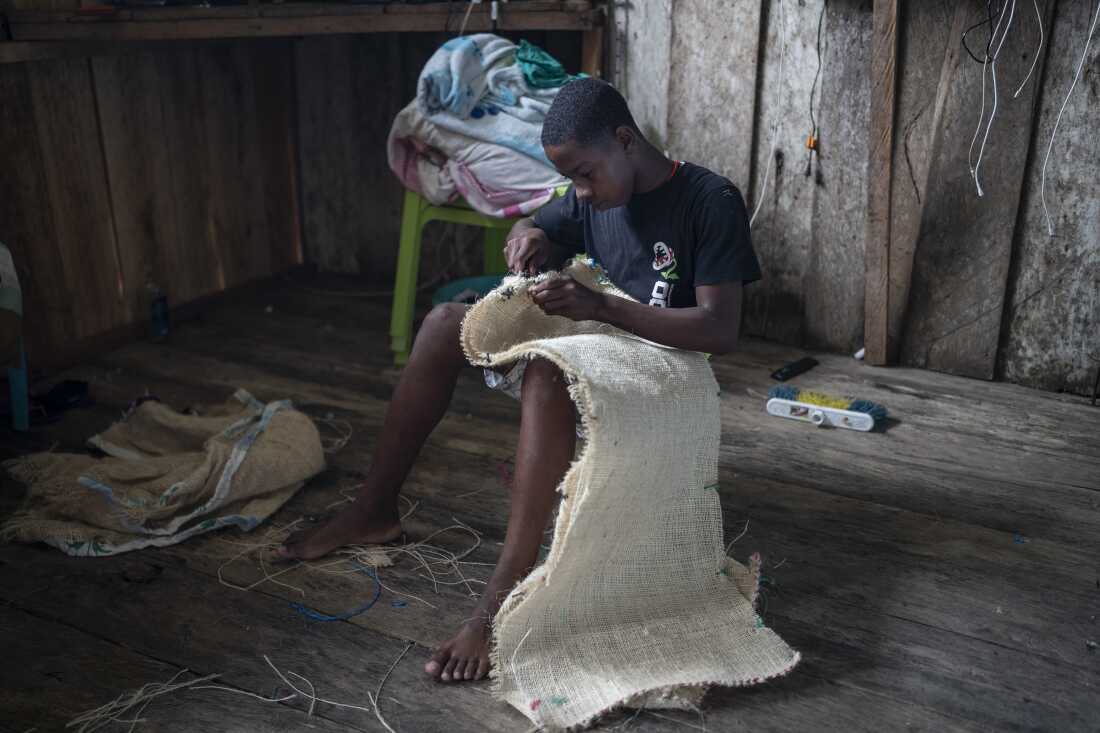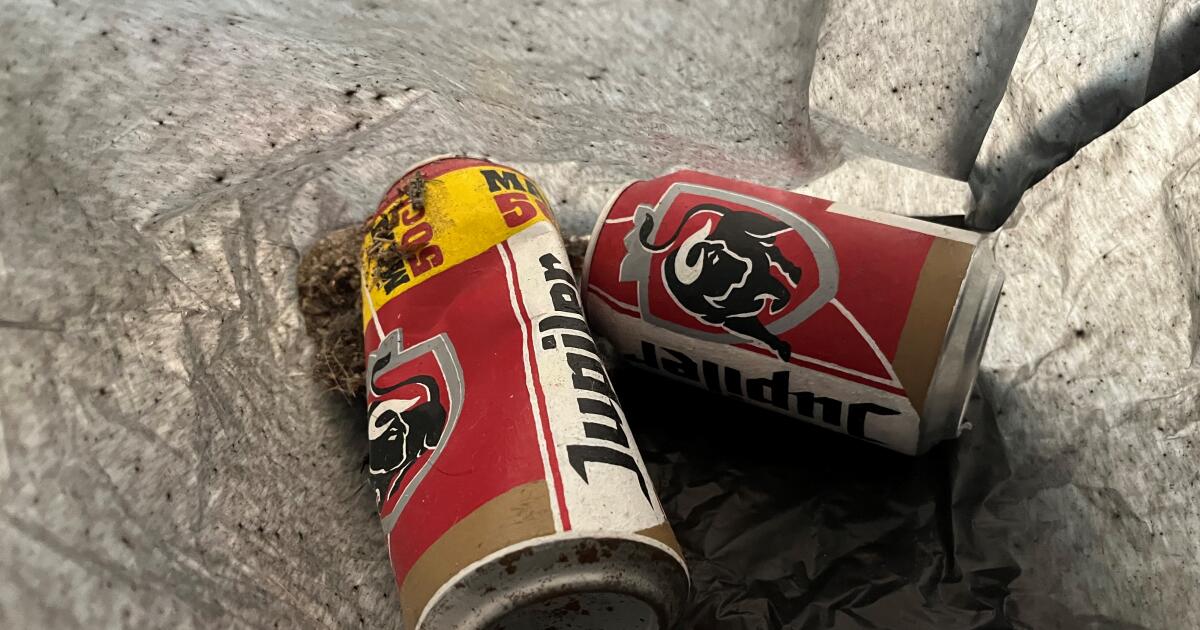Lifestyle
Twisted Creativity Takes Home Top Honours at Hyères


Lifestyle
How one Afro-Colombian community honors their ancestry

Camilo Garcia peeks through a curtain of his house on the morning of March 29, 2024, in the town of Juntas, Buenaventura, Colombia. The community gathers during Holy Week to celebrate the Manacillos festival, an ancestral ritual originating in the upper part of the Yurumangui River.
Nathalia Angarita for NPR
hide caption
toggle caption
Nathalia Angarita for NPR
It’s Spy Wednesday, almost 6 a.m. At the shipyard port in Buenaventura, the major port city in Colombia’s Pacific region, the last wooden boats are about to depart for the Afro-Colombian communities along the Yurumanguí River.
Dozens of people embark on a journey that can last up to eight hours, crossing the Pacific Ocean, skirting cliffs and navigating through mangroves. Most passengers now live far from their native territory, displaced to the city due to economic instability, lack of health care access, education or the region’s armed conflict.
Upon reaching the clear waters of the Yurumanguí River, wooden houses begin to appear along its banks. There are 13 settlements in the river basin, home to approximately 4,000 residents, mostly descendants of enslaved Africans and maroons brought to work in the mines between the 17th and 19th centuries.
In a context of geographic isolation and state neglect, where illegal armed groups have a substantial presence, the Afro community of Yurumanguí comes together despite intimidations to celebrate the Manacillos festival every Holy Week.
Far from tourists, this ancestral and unique ritual originated in Juntas, the uppermost village on the river, as an act of cultural resilience. During the festival, no one is allowed to work in the artisanal gold mines or the agricultural fields in the jungle.
In Juntas, the memory of slavery is alive. The Manacillos hold profound spiritual significance, reaffirming their African roots and resisting colonialism and imposed Catholicism through syncretism, creating a new collective cultural identity.

A silhouette of an Afro-Colombian woman in her home, on the night of March 28, 2024, in the town of Juntas, Buenaventura, Colombia.
Nathalia Angarita for NPR
hide caption
toggle caption
Nathalia Angarita for NPR

People arrive in boats to the village located on the banks of the Yurumangui River on March 28, 2024, in Juntas, Buenaventura, Colombia.
Nathalia Angarita for NPR
hide caption
toggle caption
Nathalia Angarita for NPR

A boy designated to be one of the Manacillos sews his costume for Holy Week on March 29, 2024, in Juntas, Buenaventura, Colombia.
Nathalia Angarita for NPR
hide caption
toggle caption
Nathalia Angarita for NPR

Camilo Garcia on the morning of March 30, 2024, in the town of Juntas, Buenaventura, Colombia.
Nathalia Angarita for NPR
hide caption
toggle caption
Nathalia Angarita for NPR
Manacillos: Spiritual beings
It’s Maundy Thursday. The community has adorned the cobblestone streets and balconies with corozo palm leaves. Ayerson Valencia and Henry García finish sewing their Manacillos costumes with the help of female family members. Meanwhile, in the same room, some women braid their hair, paint their nails, and try on elegant dresses.
The typical Manacillo’s costume is made of burlap sacks and banana leaves and is often adorned with colorful fabric patches. Additionally, every Manacillo wears a slender leather whip fastened to their waist, which they use to “punish” the other participants during the Manacillos’ games.
Along with this, the rest of the costume consists of a distinctive and colorful mask carved from balsa wood sourced within their own jungle. In the backyard of his house, 15-year-old Henry applies the final touches to his mask, painting a red smile reminiscent of the Joker’s.
The masks of the Manacillos transform the wearer into spiritual beings. “Every year, we decide what type of mask to paint, reflecting how we want to be perceived. Some evoke fear, others are humorous,” he says.
Meanwhile, some men are completing the construction of the Manacillos’ house, a small wooden structure located in the center of the village that faces the church. Here, the group gathers to play traditional Manacillo songs, recharge with viche — a traditional alcoholic beverage of the Afro-Pacific communities — and plan their next activities. During the Manacillos’ game, they attempt to steal Jesus’ coffin, play pranks, tease passersby, steal objects and even “kidnap” locals, including babies, for ransom.
There is no age limit to become a Manacillo, as membership is inherited from parents by their sons or other close male relatives after they pass away. This year, the youngest member is 7-year-old Leandro Valencia, who inherited the role after his father, a leader in the community, died in exile. Over the next few days and nights, he plays his role tirelessly, just like a child.
Adolescents such as Henry, who has been playing the role for five years, feel a strong sense of pride: “I became a Manacillo to honor our ancestors and preserve our cultural heritage. My goal is to pass down this knowledge to the younger generation so that our traditions are not forgotten.”

People walk through the town in a procession while singing traditional songs at midnight on March 29, 2024, in Juntas, Buenaventura, Colombia.
Nathalia Angarita for NPR
hide caption
toggle caption
Nathalia Angarita for NPR

Women sing religious and ancestral songs during a Holy Week procession on March 29, 2024, in Juntas, Buenaventura, Colombia.
Nathalia Angarita for NPR
hide caption
toggle caption
Nathalia Angarita for NPR
Resistance through the traditional music
Holy Week is celebrated differently here. In their tradition, Jesus’ death occurs at midnight on Thursday, not on Good Friday. The ritual begins with a procession of Jesus the Nazarene and is repeated nightly until Easter Sunday. During this religious syncretism, the village is shrouded in darkness, illuminated only by candlelight.
The village catechist, Delio Valencia, and the altar boys chant prayers while carrying leaf-adorned statues of Jesus and his mother, Mary. Leading the procession, a group of women sing soulful and loud salves and alabaos — traditional Afro community songs for religious rituals and funerals to bid farewell to the deceased. Their bodies sway with the rhythm.
At the front of the crowd, Luz Damaris García, a 49-year-old vocalist, sings with a deep, raspy voice. Tears glisten in her eyes as she holds her friend’s arm. Both sway gently, harmonizing the lyrics and melody. “The salve is like a feeling. It reminds us of those who have departed,” she says.
That night, the ceremonial procession visits the local cemetery, where three solitary souls, portrayed by trembling men in white sheets, descend from the sacred heights. Children hold their mothers’ hands tightly, some crying, others laughing. They will sing their unique religious songs in the church until 4 a.m. The Manacillos will not appear until the next day.
The main outer wall of the church is adorned with a large painting of the last two social leaders who disappeared at the hands of armed groups. The painting includes the phrase, “We will die on the day we remain silent in the face of injustices.”
One of the leaders was 79-year-old Delio’s son. “During prayers, we always entrust ourselves to them, who lost their lives to free the Yurumanguí River and liberate their people,” he says.

People dress up as souls in purgatory coming down from the cemetery at midnight on March 29, 2024, in the town of Juntas, Buenaventura, Colombia.
Nathalia Angarita for NPR
hide caption
toggle caption
Nathalia Angarita for NPR

The Manacillos make a representation of the Pharisee soldiers who collaborated with the death of Jesus Christ, dressed in local tree leaves and colorful wooden masks, on March 29, 2024, in the town of Juntas, Buenaventura, Colombia.
Nathalia Angarita for NPR
hide caption
toggle caption
Nathalia Angarita for NPR

A person dressed as a Manacillo rests during a celebration on March 29, 2024, in the town of Juntas, Buenaventura, Colombia.
Nathalia Angarita for NPR
hide caption
toggle caption
Nathalia Angarita for NPR

The Manacillos make a representation of the Pharisee soldiers who collaborated with the death of Jesus Christ, dressed in local tree leaves and colorful wooden masks, at midnight on March 29, 2024, in the town of Juntas, Buenaventura, Colombia.
Nathalia Angarita for NPR
hide caption
toggle caption
Nathalia Angarita for NPR
The rules of the Manacillos’ game
Originally, the Manacillos’ ritual commemorated the passion, death and resurrection of Christ in their unique way. The group started with 12 men led by a Manacillo named Barrabás, after the Biblical figure, and has now grown to nearly 40. According to oral tradition, the Manacillos are the spirits of the Jews who betrayed and executed Jesus.
The Manacillos’ play begins on Good Friday evening, and they are not allowed to sleep for the next 48 hours. Before singing, the masked men shout, “Death to God and long live Barrabás!” The rest of the community responds, “Long live God and death to Barrabás!”
The celebration begins with the drumbeat. A woman initiates a melodic chant: “On Holy Thursday, God died; on Friday, they buried him; on Saturday, they sang his glory; on Sunday, he ascended to heaven.” Other musicians join in with traditional instruments — bass drum, cununo and guasá, which sounds like water. The song is repeated several times.
Everyone is covered in sweat, the musicians seeming to merge with their instruments. The female singers and other participants repeat the song without showing signs of fatigue, their voices full of emotion. The music creates a mystical trance and euphoria among the participants. No other music is allowed until Easter Sunday; otherwise, the Manacillos will punish the offenders with whips.
Over the next few days, the entire community gathers in Juntas, captivated by the nocturnal warmth and viche spirits. Amid this fervor, the game’s characters dance, leaping from side to side, holding their attires. The youngest members of the community move from house to house, singing in honor of the Manacillos.
“Music helps us preserve our identity amid the armed conflict. Today, many children prefer picking up an instrument over a weapon,” explains Franklin Valencia, an instrumental musician from the popular group Matachindé.

A person holds a gold necklace with the image of Jesus Christ on March 29, 2024, in the town of Juntas, Buenaventura, Colombia.
Nathalia Angarita for NPR
hide caption
toggle caption
Nathalia Angarita for NPR

A child dresses up as a Manacillo on March 30, 2024, in the town of Juntas, Buenaventura, Colombia.
Nathalia Angarita for NPR
hide caption
toggle caption
Nathalia Angarita for NPR
More than daily violence
During the Manacillos’ dramatization, violent scenes occur as they are allowed to punish locals and vice versa. Many suggest that beneath the Manacillos’ masks are community members affiliated with armed groups. These individuals get permission from their superiors during Holy Week to play the role before returning to the wilderness.
The festival enables improbable encounters in daily life. Civilians and soldiers from different armed groups come together in the same space without violence. Solange Bonilla Valencia, a Ph.D. student in social anthropology and a specialist in peace, culture and international humanitarian law, explains that in the tense conflict of Yurumanguí’s river communities, violence takes on a spiritual dimension — a collective release.
“It’s a moment of catharsis, a chance to encounter the other. The fear of being struck with a whip is different from the fear of being killed with a firearm,” she says.
Amid the exuberant nature along the banks of the Yurumanguí River, prominent signs bearing the insignias and messages of the Jaime Martínez Group, an illegal armed faction of the demobilized guerrilla Revolutionary Armed Forces of Colombia (FARC), appear every few kilometers upstream. The dissident group displays its presence and activity in the territory. The ever-present, yet hidden, eyes that intimidate the inhabitants.
The conflict among armed groups for control over this territory has intensified due to its strategic location for drug trafficking. The celebration has changed, and there is fear of losing ancestral traditions. “Many former Manacillos can no longer participate,” Angulo explains. “Some were killed, others relocated due to insecurity.”
Angulo, a 60-year-old human rights defender and active Manacillos leader who is identified only by his last name for his safety, as he plans on returning for future celebrations, spent several years away from his homeland due to the threats posed by the armed groups. Now, he is enthusiastic about the significant number of community members who have returned for the four-day celebration.
The Manacillos’ festival is not only a moment of joy and a break from routine but also a time to remember deceased relatives, return to the territory and reinforce social ties. “I was raised in this jungle and then forced to leave, abandoning my children and traditions,” he says. “That had a profound impact on me. Here, I feel good. I’m not a city man.”
In late November 2021, two prominent social leaders, Abencio Caicedo and Edinson Valencia, were kidnapped by armed groups, plunging the community into distress and fear. Even the popular Manacillos festival was temporarily silenced by the residents’ grief.
“The loss of a leader is a huge pain. Many have been killed, the most important leaders are lost, and we are left unprotected,” says Luz Damary.

People carry religious representations while walking on the Manacillos on March 31, 2024, in the town of Juntas, Buenaventura, Colombia.
Nathalia Angarita for NPR
hide caption
toggle caption
Nathalia Angarita for NPR

People carry religious representations while walking on the Manacillos on March 31, 2024, in the town of Juntas, Buenaventura, Colombia.
Nathalia Angarita for NPR
hide caption
toggle caption
Nathalia Angarita for NPR

Children disguised as Manacillos in the Yurumangui River on March 31, 2024, in Juntas, Buenaventura, Colombia.
Nathalia Angarita for NPR
hide caption
toggle caption
Nathalia Angarita for NPR

A person wears a Manacillo costume representing the Pharisee soldiers who collaborated with the death of Jesus Christ, on March 31, 2024, in the town of Juntas, Buenaventura, Colombia.
Nathalia Angarita for NPR
hide caption
toggle caption
Nathalia Angarita for NPR
The Yurumanguí River as a living entity
For the Yurumanguireños, the river is a living entity and an essential part of their community. Daily life revolves around its waters. Children learn to swim before they can speak. Women wash clothes and kitchen utensils in the river, which also serves as a natural shower and the main route for transporting wood, fish and fruits. The crystalline waters are surrounded by a lush, dense jungle that conceals sugarcane, plantain and corn fields, their primary sources of sustenance.
“Their primary concern is to safeguard the territory for future generations,” Bonilla explains. “They emphasize the vital role of a thriving, preserved river in sustaining life. They warn that neglecting the river, especially through heavy machinery in gold mining, would deprive future generations of the essence of life itself.”
“The river is life,” the inhabitants of Juntas reiterate when asked about its significance. The sentiment is evident in their efforts to protect the river from external threats, a struggle that has claimed the lives of several social leaders.
It’s Easter Sunday. After three sleepless nights, few seem tired. Once the rain stops, the Manacillos and the rest of the community — this time without the elderly or the children — march toward one of the river’s beaches. Despite the previous night’s alcohol, they skillfully cross the river. Some dive into the water while others fall asleep on the shore.
During the parade, the sound of the Manacillos’ songs resonates continuously, and everyone dances in ecstasy. This time, a few women, known as Manacillas, join them. Dressed in banana leaves and wearing straw hats adorned with colorful strips of plastic, they play their role while smoking prominent tobacco leaf cigars.
“Wearing the Manacilla attire brings me joy and fulfillment, connecting me deeply with memories of my grandmother,” says 18-year-old Manacilla Camila García Valencia. “I am honored to uphold her legacy.”
The procession returns to the village, where children and the elderly gather around the church, dressed in their best clothes. As Jesus rises from the dead, the Manacillos throw themselves to the ground, acknowledging his resurrection. Now, they are believers.
Once inside the church, everyone dances to the rhythm of drums and bells. After several minutes, the instruments fall silent and the Manacillos retreat into the mystic world. Those behind the masks return to being ordinary people. The game between life and death ends in the ritual, but not in real life. “We are free here,” Angulo says. “Look at the river! We just want more security in our territory.”

The community gathers at the river on the last on the last day of Holy Week on March 31, 2024, in the town of Juntas, Buenaventura, Colombia.
Nathalia Angarita for NPR
hide caption
toggle caption
Nathalia Angarita for NPR
Nathalia Angarita is a documentary photographer and Marina Sardiña is a reporter, both are based in Bogotá, Colombia. You can see more of their work on instagram at @nathalianph and @marina_sardina
Lifestyle
Walt Whitman, gay love and a posthumous novel

The cover of Song of Myself: A Novel by Arnie Kantrowitz
Tatiana Fernandez/Sentinel Voices
hide caption
toggle caption
Tatiana Fernandez/Sentinel Voices
Daniel Dell Blake doesn’t want to fit in. He wants the right to stand out.
But in a small fictional town of Elysium, New York, that’s a dangerous wish.
Blake is the main character in – Song of Myself: A Novel.
He was created four decades ago by a gay rights pioneer – Arnie Kantrowitz.
Now – nearly three years after Kantrowitz’s death – his partner has succeeded in finally getting the novel published.
On an overcast day in New York City’s West Village, Dr. Larry Mass shuffled across the polished concrete floor of the New York City AIDS Memorial.
He’s part of the Stonewall Generation — a cohort of LGBTQ activists who were energized by the Stonewall uprising in 1969.
Dr. Mass is a co-founder of the Gay Men’s Health Crisis and he wrote the first news report on AIDS.
At the memorial – he stopped at the end of an inscription etched into the floor.
“Failing to fetch me at first, keep encouraged,
Missing me one place, search another.,
I stop somewhere here, waiting for you,” Mass read.
Those are the final lines from Walt Whitman’s poem “Song of Myself,” which is included in his seminal poetry collection Leaves of Grass.
For Mass, Whitman, the poet, is fundamentally entwined with memories of his partner.
“No matter what horror or tragedy you’ve gone through, no matter what pain, no matter what color you are, no matter what religion. He embodies that. He will always be there,” as Mass began to weep.

Dr. Larry Mass reflects on his partner Arnie Kantrowitz’s legacy at New York City’s AIDS Memorial.
Ryan Benk/NPR
hide caption
toggle caption
Ryan Benk/NPR
Sitting near the memorial’s fountain, he explained why Whitman’s words have long been so important to many queer people.
“Society does not acknowledge these people in any way, shape or form,” he said. “They have no idea even who they are. And here’s this poetic voice of humanity who keeps saying again and again ‘I am your voice. I am your spirit. I am the grass on which you stand.’”
Mass’s partner – Arnie Kantrowitz – was not only a scholar of Walt Whitman – he considered him part of his life and soul.
That closeness informs Kantrowitz’ novel, “Song of Myself” – and the journey of its protagonist, Daniel Dell Blake.
In the book, a knowing teacher gifts young Daniel a copy of Leaves of Grass, and Daniel carries that collection of poetry along with him – from the home of his tyrannically religious father, to New York City and his first love, to a World War II POW camp, and then back to the U.S., where Daniel is jailed for sodomy.
The character’s experiences mirror the history of gay life in the 20th century.
At a book launch event last month in New York City’s LGBT Community Center, friends and fellow activists talked as much about Arnie Kantrowitz’s life and legacy as the fictional adventure he wrote.
John Adrian took one of Kantrowitz’s gay literature classes at the College of Staten Island in the 1990s.
“He was so open and honest about who he was and I thought ‘he’s awfully bold,’” Adrian said.
Adrian added that the scholar and gay rights activist taught him to be unapologetic.
That characteristic was on full display in a 1973 appearance on Jack Paar Tonite, when Kantrowitz turned a homophobic barb back on the late night host, winning laughs from the crowd and even getting a chuckle from Paar himself.
YouTube
It’s that cleverly charismatic version of Arnie Kantrowitz that the gay activist wrote into his own novel, imagining a meet-up with the adult Daniel Dell Blake at a rally.
Kantrowitz co-founded the organization now known as GLAAD – and was recognized in the 1970’s for his autobiography “Under the Rainbow: Growing up Gay.”
But as he got older, he wasn’t as widely known as others in his circle.
Judith Stellboum, who taught literature at State Island College with Kantrowitz, said the man she worked with just didn’t care about publicity.
“He never was pretentious. If you didn’t know about his book he never would say ‘I’m Arnie Kantrowitz and I wrote the first book about … ‘ You know, he didn’t have an ego like that,” she said.
Kantrowitz started writing his Song of Myself in the 1980s – and an editor’s note says that since it’s being published posthumously, the decision was made to only copy edit the story. It also acknowledges that the novel is a product of its time, and could have used sensitivity readers to review some of his characters.
Still, the novel is empathetic and funny and fiercely defensive of all marginalized people – something Kantrowitz was always known for.
Back at the AIDS Memorial, Dr. Larry Mass remembered when his partner gave up on publishing his novel.
“Arnie’s heart was broken that it didn’t find a home in this first go-around, but that happens. It was also happening during the height of AIDS and he didn’t want to bother people,” Mass recalled.
Kantrowitz just thought there were probably more important stories to tell at the time, but Mass thought then – as he does now — that his partner’s words are timeless.
Mass hopes that, just like how Daniel Dell Blake finds himself in Walt Whitman’s words in Song of Myself, maybe some other fellow traveler might some day find themselves in the words of Arnie Kantrowitz.
Lifestyle
How to have the best Sunday in L.A., according to Abby Wambach

Imagine it: Soccer legend Abby Wambach, five years old and a gifted forward, scoring 27 goals in her first three youth soccer games.
Now widely known, it’s a story that Wambach shares often to emphasize the importance of working with teammates, or what she calls her “wolfpack.”
“After my third game, my mother asked me why I didn’t pass the ball,” recalls Wambach, 44. “I said the whole point is to score the most goals. She told me, ‘It is going to make you lonely. None of your teammates will want to be friends with you.’ Since then, I have prided myself on passing the ball and building up my teammates. It was the beginning of my life of gratitude.”

In Sunday Funday, L.A. people give us a play-by-play of their ideal Sunday around town. Find ideas and inspiration on where to go, what to eat and how to enjoy life on the weekends.
Empowerment is a theme that runs throughout Wambach’s activism, speaking engagements, and now, “The Wolfpack Way,” a picture book for children that arrived in bookstores this week. For even with her formidable soccer skills (following her debut, she was moved to the boys’ team), Wambach says she felt powerless as a child. “All of the decisions were being made for me,” she says. “So I created a picture book I wish I had growing up — full of inclusivity, teamwork and diversity.”
When she’s not writing books, the two-time Olympic gold medalist and former U.S. women’s soccer team captain co-hosts the weekly podcast series “We Can Do Hard Things” with her wife, best-selling author Glennon Doyle, and Doyle’s sister Amanda. Recently, the couple has been on the road with their 17-year-old daughter, singer-songwriter Tish Melton, who is performing in her first tour. When she is home, Wambach would start her ideal Sunday surfing in Manhattan Beach, followed by a walk along the Strand and an Angel City FC soccer game, of which she is a part owner. With time flying by, Wambach appreciates spending time with two of their three teenagers while they are still at home. “I have gold medals and championships,” she says, laughing, “but I assure you: my kids don’t think I’m remotely cool.”
This interview has been lightly edited and condensed for length and clarity.

7 a.m.: Catch a wave — or not — at El Porto
After making my morning coffee at around 6 a.m., I will go surf at El Porto just north of Manhattan Beach. I’m a novice. All I do is paddle around and fall off, but it doesn’t matter. It’s magic when you’re in the water, and it’s crisp and cold, and the dolphins are going by. There is a reason you keep getting called back to the ocean, even if you never catch a wave. Nothing else in life can replicate the feel of the water. You’re using Mother Nature to do something to move. You’re taking on a marine animal experience. Surfing is complicated, so when I get it down, it feels like a whole human experience when I’m done. I’m always so hungry afterward. It reminds me of when I played soccer and what it would feel like when I got off the field. I usually grab a burrito from Brother’s Burritos to warm me up after.
Every once in a blue moon, our youngest daughter Amma has a Sunday soccer game; in that case, you’ll find me on the sidelines at her game. At first, the other parents considered me a soccer extraordinaire and wanted to hear stories, but after several years, I’ve become a normal parent.
Noon: Take a walk with Glennon and map out the week ahead.
Our Sunday walk is when we catch up on personal and family stuff and what is circling around in our world. I love walking along the Strand bike path in the beach cities. We use our weekend walks to form what we discuss on the podcasts. We talk a lot about ourselves and plan for the week ahead. Sometimes, you need to have that quality time with your partner with no cellphones in hand. There is often a lot of silence. When you have three teenagers and are doing big business endeavors, finding that solitude and planning the week is one of those things that we really need as a couple.

2 p.m.: Indulge in a nap
In the afternoon, I’ll take my Sunday nap. To be completely honest, I am a napper on Monday, Tuesday, Wednesday, Thursday, Friday and Saturday too. This is a regime that I brought from my playing days. It’s important. I think that’s why I can wake up so early — I know I’ll get a nap in the afternoon.

3 p.m.: Hit the cold plunge and sauna
After my midday nap, I like to take a cold plunge in the garage in my inflatable Edge Theory Cold Plunge. I’ll do a cold plunge, then have a sauna. I like to pretend I’m a wannabe professional athlete and have to prepare for a big game.

4:30 p.m.: Attend an Angel City Football Club game
If we are in town and they are playing, we are at the Angel City soccer games at BMO Stadium. It’s such an awesome environment to have 22,000 people at every game. I feel so much joy — and jealousy — that this is their weekly experience as professional soccer players. It’s such a fun thing for us to be a part of. The kids go with us too. We have seven season tickets, and sometimes we bring friends. It’s an experience that you don’t have elsewhere. We are all accustomed to going to football and basketball games for men. Women’s soccer games are just as intense, but they are also open and welcoming. You see moms and daughters, entire families and soccer teams from all over Los Angeles. There is a support section that never sits down. It’s so entertaining.
7 p.m.: Cook dinner and watch “Friday Night Lights”
I am the cook of the family, although Glennon has been dabbling recently. We have two kids at home — our youngest is a junior in high school — and that’s when everyone comes together. We normally like to have an early dinner and watch TV shows together as a family. If I cook, everybody else does the dishes. Once the dishes are done, I’ll make Glennon and me some tea, and then we will sit down in the family room, hang out and spend five minutes figuring out what we will watch while our teenagers do their homework. We are into “Friday Night Lights” at the moment. It’s such a great show, and it’s fun for us because the kids haven’t seen it. Spending time with each other on Sunday evening is a great way to ease into Monday and a big week ahead. We fight off the Sunday scaries a little bit with our Sunday routine.
-

 Technology1 week ago
Technology1 week agoBeware of fraudsters posing as government officials trying to steal your cash
-

 Health1 week ago
Health1 week agoHealth, happiness and helping others are vital parts of free and responsible society, Founding Fathers taught
-

 Sports1 week ago
Sports1 week agoFreddie Freeman says his ankle sprain is worst injury he's ever tried to play through
-

 News1 week ago
News1 week agoLebanon says 50 medics killed in past three days as Israel extends its bombardment
-

 Entertainment4 days ago
Entertainment4 days agoHold my beer can: Museum says a worker thought unique art installation was trash
-

 Entertainment5 days ago
Entertainment5 days ago'The Office' star Jenna Fischer reveals private breast cancer battle: 'I am cancer free'
-
/cdn.vox-cdn.com/uploads/chorus_asset/file/25673932/462754179_560996103109958_6880455562272353471_n.jpg)
/cdn.vox-cdn.com/uploads/chorus_asset/file/25673932/462754179_560996103109958_6880455562272353471_n.jpg) Technology1 day ago
Technology1 day agoMeta suggests AI Northern Lights pics are as good as the real thing
-

 Technology3 days ago
Technology3 days agoScammers exploit grief with fake funeral streaming on Facebook













